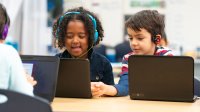How to Encourage Physical Computing in Elementary School
With simple coding options available, elementary school teachers can incorporate computer science across content areas.
Your content has been saved!
Go to My Saved Content.Before I was a computer science and technology specialist, I was an elementary homeroom teacher. Often, I’d ask, “What are the ways I can engage students in the learning process?” So began my love of tools and manipulatives in the classroom. I was able to show my students when they were stuck on a skill that a variety of tech tools offered alternatives for their learning.
Now, as an elementary computer science teacher, when collaborating with classroom teachers I find there’s often a natural gravitation to have the students combine code and classwork during math class. If you’re ready to integrate STEM into literacy, humanities, or social studies plans, however, there are ways to engage students using computer science techniques and going beyond research consumption.
Coding Across Content
Elementary teachers no longer have to fear the code. Each year, platforms are created for younger students to understand basic computational thinking concepts in easier ways. Block code is visual instruction (converted text-based code) that uses a drag-and-drop interface for code. With an entry-level activity, students can learn strategies prior to handling text-based code. An easy way to include basic coding, especially for teachers new to code, is to create literacy storytelling with tools such as ScratchJr or CS First Storytelling units.
Another way to up your STEM game in the social science areas is by including physical computing, which allows students to interact with more than just a screen. When students connect code they created on the computer to an object, like a circuit board with a cord, you can hear the delight when they realize their code is running properly. Makey Makey and micro:bit are two tools that help beginning students understand physical computing because both products let students code in block; they allow for a variety of different ideas and have the benefit of applying basic circuitry concepts in addition to the coded curriculum connection.
How deeply teachers go into the code depends on the students’ age and stage of experience. For second-grade students, my goal is to have the students successfully set up the tools and run a sound code that the teacher has modeled for them. Using play-dough attachments, the students also create visuals from a story based on what they’re reading at the time in class—in this case, it was Patricia Polacco picture books.
In third grade, students can use Scratch, which is the version geared to older students who have graduated from ScratchJr, to create the sound effects themselves. During the unit of study on the different regions in the United States, students use play dough to create representations of regional artifacts. With each group taking a region, this makes for a fun gallery walk for the students to see and try each other’s creations.
As students move on to fourth grade, we change the use of the tool to create blackout poetry applying Colleen Graves’ techniques. Using a copy of a page from what they’re reading in book clubs, students select words and with a lead pencil create a conductive circuit to the sound they’ve coded.
As the students progress, we start to introduce them to LED lights and micro:bit. The micro:bit site provides an assortment of tutorials to get the students started. Using the MakeCode for micro:bit platform, we adapted one of the basic programs, Name Tag, so that students could code display names or facts about their research on presentation boards in social studies. This takes the students’ presentations to the next level by combining written work with the scroll feature of lights.
The MakeCode for micro:bit platform also allows students at the upper elementary levels to differentiate because the site offers block code for beginners. In addition, micro:bit provides Python and Java coding opportunities for those students who may be involved in additional enrichment coding activities outside of school.
As a specialist in technology, I’m serving not only the students but also the teachers. There are definitely more advanced physical computing products using breadboards or Raspberry Pi devices that are amazing; however, teachers who want to get involved can start to hone their integration with technology skills with one basic tool and advance as they and their students master.
While the needs of students and teachers differ, the concept of low floor, high ceiling applies, no matter who is learning. If you feel you are at the low floor level of learning computational thinking, begin with one of the starter challenges with block code by integrating it into your humanities project-based learning. Once you capture the wow factor when your students see their creations come to life, you’ll want to try more.
